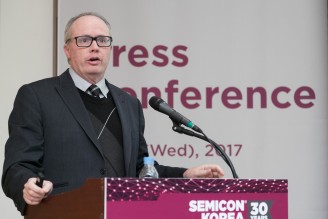Market forecasts vary in the range of between the lowest of a year-on-year 3.3% growth by WSTS to the highest of a year–on-year 7.2% by Gartner, but the 2017 will be for sure the break-out year for the boom cycle of global semiconductor chip market.
At a press conference held at SEMICON Korea trade show on Feb. 8, Dan Tracy, senior director industry research & statistics with SEMI said, “Connectivity, networking, and cloud computing enable new applications and services,” setting off demand boom for semiconductor chips.
He pinpointed as key growth drivers four applications –storage, industrial, wireless, and automotive.
True enough, massive transformations in the way that consumers and corporations use services and information are presenting new market opportunities for semiconductor chip makers, setting new trends like Big Data Analytics, cloud computing and IoT.

Busy chip design activities
For example, consumers are now taking photos or shooting video clips with their smartphones to store and upload them to share with friends or unknown people through social media networks. That application is requiring more storage spaces across their devices including smart phones, tablets, and notebook PCs, and even fitness and healthcare IoT devices. The same is true in industrial and logistics IoT applications that are clamoring more of sensors, CPU processors, and embedded memory chips. Cars are also consuming more of silicon contents like vision and image processors, embedded memories, CPUs, and other sensors, as they are not just increasingly connected with each other or via the Internet, but also going digital to get safer, smarter and lighter. For example, a growing number of top-tier premium car models are coming equipped with ADAS, or advanced driver assistant systems warning car users not to depart lanes, alert them of incoming objects in the blind spots, or imminent car collisions. These car safety applications are fueling demand for sensor fusion MCUs, sensors, and embedded memory chips.
Memory chips lead upward cycle
At the other end of the applications continuum are data center servers that have spouting up across mobile service carriers, SNS providers, cloud computing service providers, extremely craving for enormous enough computational processing power and storage spaces to store process, analyze, and feedback data.
Chip demand is also booming across a cobweb of cellular broadband networks that underlies all these applications, as explosions in the data traffic are calling for more of bandwidth resources like 4G network.
“Semiconductor chips became so pervasive in products that global demand for all goods and services has become the critical semiconductor driver, “added Dan Tracy, senior director industry research & statistics with SEMI.
Reflecting the growing dynamics in the chip design activities, SEMI forecasts that global semiconductor equipment market would jump 9% from US$39.69 billion in 2016 to 43.40 billion in 2017.
Especially, booming chip design activities in NAND flash memory chip makers and contract chip maker foundries will drive the capital spending. Demand for NAND flash memory chips are exploding, as NAND flash memory chip-based SSDs, or solid state disks are replacing conventional HDDs in high volume across a broadening spectrum of server computers. Fondury contract chip makers are also keeping their fabrication lines at full throttle to meet a rush of contract hip making orders for applications processors, modem chips, CPUs, and image sensor processors, FPGAs, high performance interface chips, sensors, and other analog chips.
Investment frenzies in NAND flash memory chips
For example, Samsung is now expanding, or newly building its 3D NAND flash memory chips capacity in Xian, China and Pyungtaek, Korea, while its backyard archrival S.K. Hynix is investing its to construct M14 3D NAND flash memory chips. Intel, Micron, Toshiba, and XMC of China are also joining the spending frenzy to keep up with booming demand for NAND flash memory chips.
In 2017 alone, US$16 billion will pour in to newly construct, or install fabrication equipment. Capital investments in contract chip-making foundries are on the rise, as world’s top 4 foundry chip maker TSMC, GlobalFoundries, Samsung Electronics, and UMC are perking up their facility investments to bulk up foundry chip-making capacity to meet busy chip design activities of fabless chip makers.
Global Foundries are investing in the phase 3 of its Fab 8, while Samsung is investing in S2 and S3 foundry fabs. TSMC is constructing Fab 2, Fab 14, and Fab 15.
Looking beyond 2020
All combined, just fewer than US$18 billion will pour in foundry fab construction or expansion projects in 2017 alone. The biggest spender is Samsung Electronics, which is forecast to spend about US$10 billion in the facility investment in 2017. Other top spenders include TSMC, Micron, Intel, SK Hynix, UMC, and Global Foundries.
Looking beyond 2020, SEMI remains bullish about the market outlook, betting that Big Data infrastructure, 5G infrastructure, image processing, ADAS, self-driving cars and storage systems will likely drive chip demand for high-performance processors, high-bandwidth interface functionality, FPGAs, ASICs, embedded non-volatile memory chips, image signal processors, and low-latency 3D NAND and controllers.

